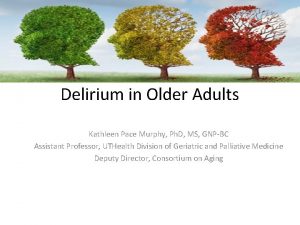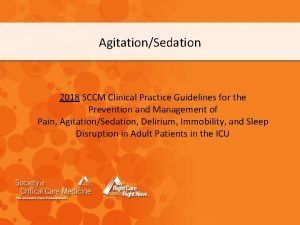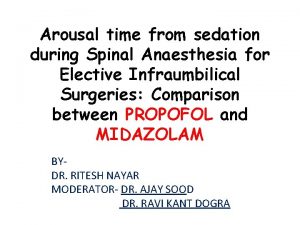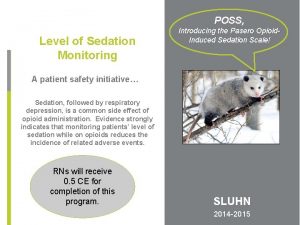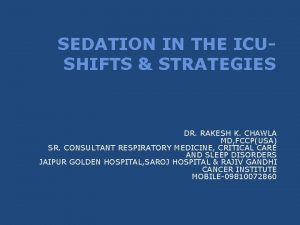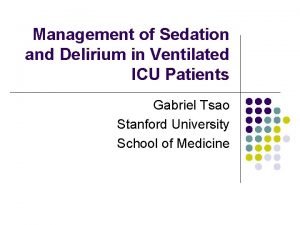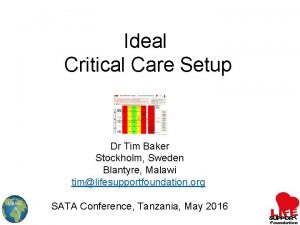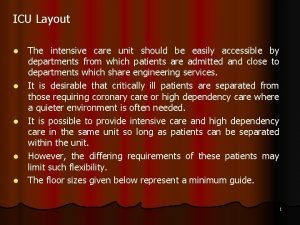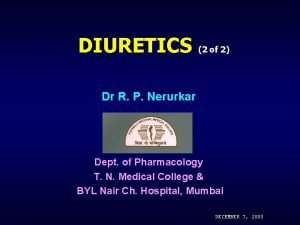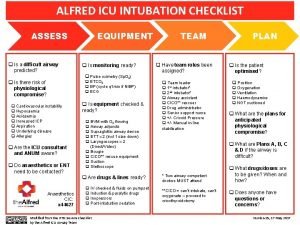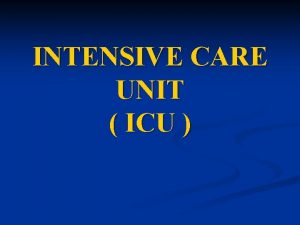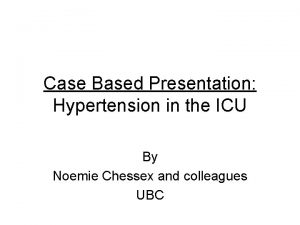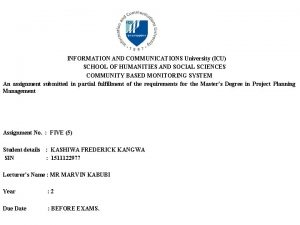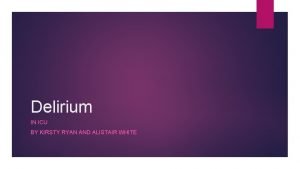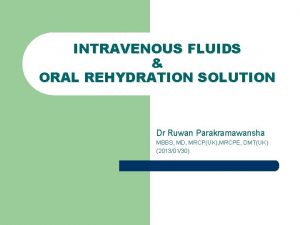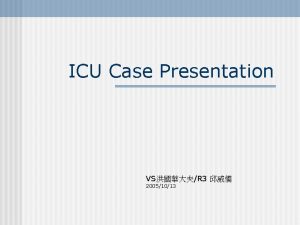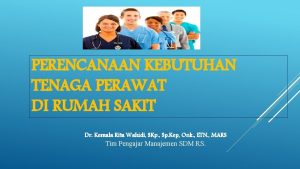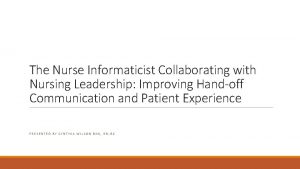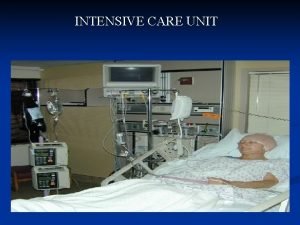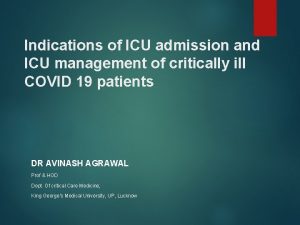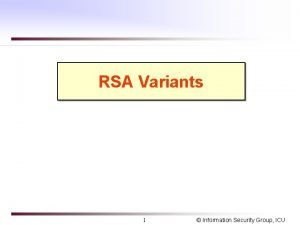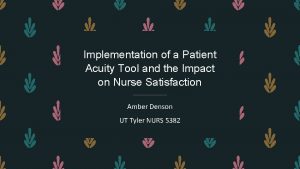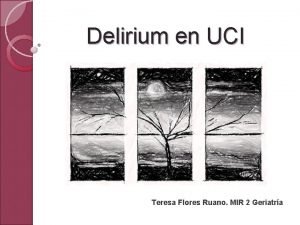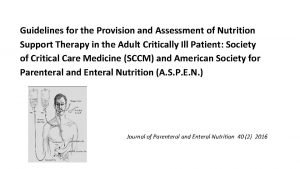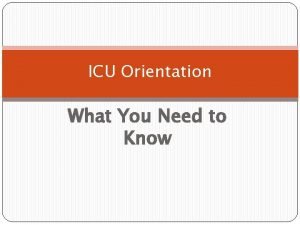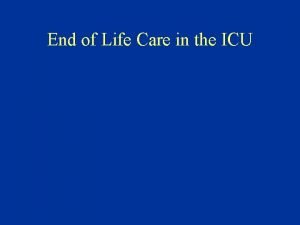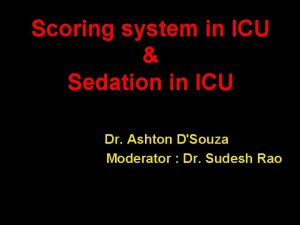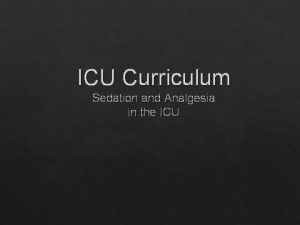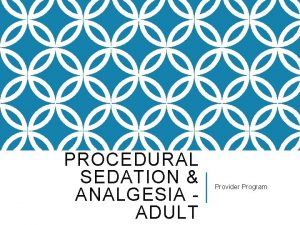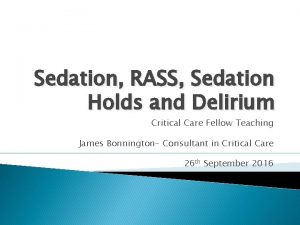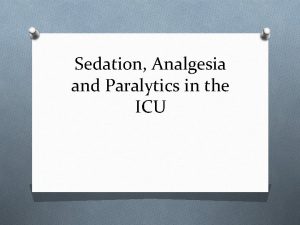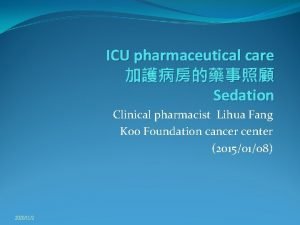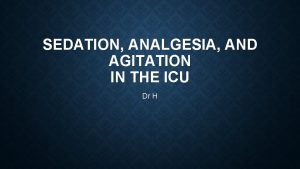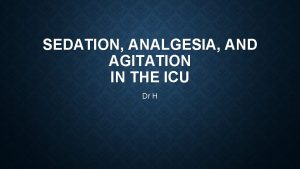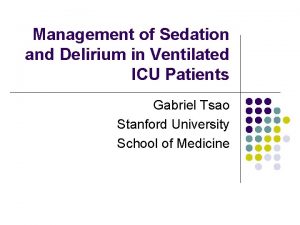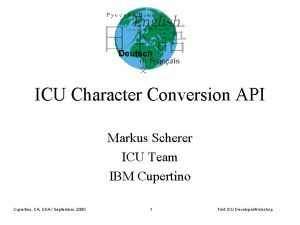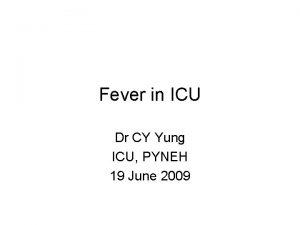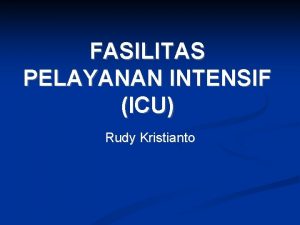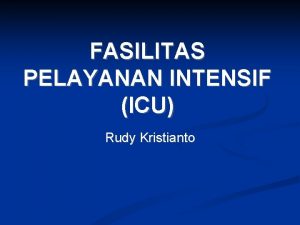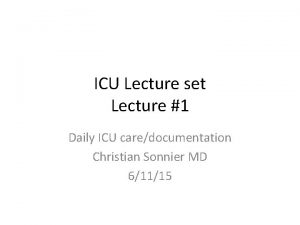Deep Sedation or No Sedation in the ICU






















































































- Slides: 86

Deep Sedation or No Sedation in the ICU? Where is the Comfort Zone? th Monday June 14 2010 Hong Kong Crit 3 cal Care Medicine and College of Anaesthesiologists Michael Ramsay MD. FRCA Chairman Department of Anesthesia Baylor University Medical Center President Baylor Research Institute.

Speaker Disclosure • I have received research grants and honoraria from: • • Hospira Care. Fusion Ikaria Masimo

• “The body when asleep has no perception; but the soul when awake has cognizance of all things, sees what is visible, hears what is audible, walks, touches, feels pain, ponders. In a word, all the functions of the body and of soul are performed by the soul during sleep. ” Hippocrates, Dreams.

• If the soul is put to sleep by pharmacological agents are our patients at increased risk for adverse events? • In Hippocrates time – 460 – 380 BC, the opium poppy was used for both analgesia and sleep inducing. The notion that the unconscious patient is insensitive to pain was the foundation of anesthesia, analgesia and sedation. • However, at that time, the sleep inducing substances (opium) had analgesic properties as well as sedative effects making this statement true. However, Hippocrates did relate the loss of consciousness in a critically ill patient with a fatal outcome.

ANALGO-SEDATION Good Analgesia FIRST as opposed to SEDATION first may provide the optimal comfort zone for the critically ill patient requiring mechanical ventilation. ANALGO-SEDATION techniques were indeed the first techniques described by Hippocrates and may improve outcomes today!

Goals of Analgesia and Sedation § Optimize safety for acute care patients and their caregivers 1, 2 § Relieve pain and anxiety 1 -3 § Attenuate the harmful adrenergic response 1, 2 § Improve compliance with care 1, 2 § Provide comfort and safety § Facilitate communication with caregivers and family members 1, 2 § Avoid or reduce delirium 1, 2, 4 1 Blanchard AR. Postgrad Med. 2002; 111: 59 -74. Care Med. 2002; 30: 119 -141. 3 Dasta JF, et al. Pharmacotherapy. 2006; 26: 798 -805. 4 Ely EW, et al. JAMA. 2004; 291: 1753 -1762. 2 Jacobi J, et al. Crit

7 Courtesy of M. Ramsay, MD. Sessler CN, et al. Chest. 2008; 133; 552 -565.

Sedation induced Coma in the ICU is Bad Ouimet S et al. Intensive Care Med 2007 8

Petty TL. Suspended Life or Extending Death? Chest 1998; 114: 360 • “But what I see these days are sedated patients, lying without motion, appearing to be dead, except for the monitors that tell me otherwise…. . By being awake and alert…they could interact with family…. feel human…sustain the zest for living which is a requirement for survival”

One Year Outcomes in Survivors of ARDS Herridge et al. NEMJ 2003; 348: 683 -93 • Functional limitations 1 year later • Most patients have muscle wasting and weakness. • Neurocognitive impairments. Hopkins & Brett. Cur Opin Crit Care 2005; 11: 369 • Depression and memory dysfunction increased in ARDS survivors. Chest 2009; 135: 678

Physical limitations after ARDS Herridge et al. NEMJ 2003; 348: 683 -93 • All reported poor function due to: • Loss of muscle bulk, proximal weakness, fatigue • • • Alopecia in most Persistent pain Entrapment neuropathies Immobility from heterotopic ossification Trach site scar problems Contractures/frozen shoulders

Critical Care 2009, 13: 216

Mobile, Awake and Critically ill Margaret S. Herridge MD MPH CMAJ • March 11, 2008 • 178(6)

Goals of Sedation Scales • • • Avoid oversedation and undersedation Define an optimal endpoint for titration of sedation Provide continuity of care and charting Facilitate cost-effective use of drugs Allow comparison of drugs Enable precise patient management.

Ramsay Sedation Scale 1 2 3 4 5 6 Anxious and agitated or restless or both Cooperative, oriented, and tranquil Responding to commands only Asleep, brisk response to stimuli* Asleep, sluggish response to stimuli* Asleep, no response to stimuli* * light glabellar tap Ramsay, et al. Brit Med J. 1974; 2(920): 656 -659.

9/10/2020 1: 03 PM


Richmond Agitation-Sedation Scale (RASS) +4 Combative +3 Very agitated +2 Agitated +1 Restless 0 Alert and calm -1 Drowsy -2 Light sedation -3 Moderate sedation -4 Deep sedation -5 Unarousable Sessler, et al. Sem Respir Crit Care Med. 2001; 22: 211 -225. Sessler, et al. Am J Respir Crit Care Med. 2002; 166: 1338 -1344.

Daily Wake-up Study: Clinical Outcomes Wake-up Group Standard of Care Group Mechanical ventilation duration (days) 4. 9 (2. 5 -8. 6) 7. 3 (3. 4 -16. 1) ICU LOS (days) 6. 4 (3. 9 -12. 0) 9. 9 (4. 7 -17. 9) *P=. 004. †P=. 02 Adapted from Kress et al. N Engl J Med. 2000; 342: 1474.

Daily Wake up In ICU • Reduced incidence of: • • PTSD Ventilator-associated pneumonia GI tract bleeding Bacteremia VTE Barotrauma Cholestasis Sinusitis Crit Care Med 2004; 32: 1272 -76

Girard TD, et al. ABC Trial The Lancet 2008; 371 126 -134 • Daily Awakening Sedation combined with Spontaneous Breathing Trial • Adding Respiratory Therapy to Sedation Team • duration of MV; ICU & Hosp LOS; Improved 1 year mortality 21

ICU SEDATION TEAM RN Patient MD

ICU SEDATION TEAM RN Patient MD RPh

ICU SEDATION TEAM RN RT Patient MD RPh

A Randomized Trial of Early Physical & Occupational Therapy in Mechanically Ventilated, Critically Ill Patients WD Schweickert, MC Pohlman, AS Pohlman et al LANCET 2009; 373: 1874 -82

Strategy • Whole-body rehabilitation “Animation” with a highly coordinated, multidisciplinary team implementing: • • Co-operative sedation Spontaneous breathing trials Good Analgesia Physical and occupational therapy • RESULTS IN: Superior functional and cognitive patient outcomes 26

ICU SEDATION TEAM RN PT/OT RPh Patient RT MD


Conclusions: Early exercise training in critically ill intensive care unit survivors enhanced recovery of functional exercise capacity, self-perceived functional status, and muscle force at hospital discharge. Crit Care Med 2009; 37: 2499 – 2505) 29

The Lancet 2010; 375: 475 -80 30

31

32

33

34

The Effect of a Positive Affect • In severe illness a positive affect is related to survival in a dose-response pattern. • Positive affect can be considered a resource for medium-term survival • Scherer & Hermann-Lingen. Gen Hosp Psych 2009; 31: 8 -13

ANALGO-SEDATION Is this the future? 36

37

Clinical Characteristics of Dexmedetomidine § Cooperative sedation 1 § Analgesia 2, 3 § NO RESPIRATORY DEPRESSION § § § Organ protection (ie, neural, renal, cardiac)1 Anxiolysis 2, 3 Controls hyperadrenergic response to stress 1 -3 Reduces shivering 3 Diuretic action 4 Mimics natural sleep 1, 5 1 Aantaa R, et al. Drugs of the Future. 1993; 18: 49 -56. T, et al. Anesthesiology. 2000; 93: 1345 -1349. 3 Wagner BKJ, et al. Clin Pharmacokinet. 1997; 33: 426 -453. 4 Goodman LS, et al. The Pharmacological Basis of Therapeutics. New York, NY: Mc. Graw-Hill; 2004: 232 -235. 5 Huupponen E, et al. Acta Anaesthesiol Scand. 2008; 52: 289 -294. 2 Kamibayashi

a 2 – Agonists and Cognitive Function • There is strong evidence that a 2 – agonists improve prefrontal cortical function (PFC) • PFC shares reciprocal projections with: • Parietal association cortex specialized for visuospatial processing • Medial temporal lobe important to memory abilities • Anterior cingulate cortex involved in organizing complex cognitive function • Caudate nucleus that regulates motor behavior • NE’s beneficial action in the PFC appear to result from stimulation of a 2 (A) – receptors postjunctional to NE terminals Arnstein et el. Arch Gen Psychiatry 1996


Dexmedetomidine for PCA/S • • • Sedation and analgesia properties Does not cause respiratory depression Rapid distribution (half life 6 mins) and elimination (half life 2 hours) Pharmacokinetics are linear for doses 0. 2 to 0. 7 mcgs/kg/h No active sedating metabolites

Methods • • Loading dose 0. 5 mcgs/kg Basal infusion 0. 2 mcgs/kg/h PCA/S patient trigger 0. 25 mcgs/kg q 20 mins Nurses adjust basal infusion rate up to 0 -7 mcgs/kg/h or down very 2 hours based on patients trigger activity

Results • • • 17 patients enrolled 9 females 8 males Mean age was 47. 1 years (+16. 6) Diagnoses included respiratory failure (n =4), pneumonia (n =3), ARDS (n =2), AIDS (n = 2), and n = 1 each for leukemia, COPD, interstitial pneumonitis, lymphangiomyomatosis, myasthenia gravis and pancreatitis.




Acta Anaesthesiol Scand 2010; 54: 710– 716


Neuroprotective effects of Dexmedetomidine • Inhibition of ischemia induced NE release may be associated with neuroprotection • Dex prevents delayed neuronal death after focal ischemia • Dex decreased total ischemic volume by 40% compared to placebo Jolkkonen J et al. Euro J Pharm 1999 Hoffman WE et al Anesthesiology 1991 • Dex enhances glutamine disposal by oxydative metabolism in astrocytes Huang R et al. J Cereb Blood Metab 2000






Sedation improves early outcome in severely septic Sprague Dawley rats Hong Qiao, Robert D Sanders, Daqing Ma, Xinmin Wu and Mervyn Maze • Conclusions Sedation with midazolam and dexmedetomidine • Both improve outcome in polymicrobial severely septic rats. • Possible benefits conveyed by one sedative regimen over another may become evident over a more prolonged time course as both IL 6 and apoptosis were reduced by dexmedetomidine but not midazolam. Further studies are required to evaluate this hypothesis. Critical Care 2009, 13: R 136

NEMJ Volume 347(15), 10 October 2002, pp 1196 -1199 Adrenergic-Receptor Polymorphisms and Heart Failure [Editorial] Hajjar, Roger J. ; Mac. Rae, Calum A.

Cardioprotective Action of Alpha 2 Agonists Anesth 2004; 101: 284 -93.

Extubation on Dexmedetomidine • Dexmedetomidine has been continuously infused in mechanically ventilated patients • • • Prior to extubation During extubation And post-extubation • It is not necessary to discontinue prior to extubation • Excellent sedation control before, during and after extubation • Consider converting to dexmedetomidine for weaning protocol

Anesth Analg. 2008 Jul; 107(1): 167 -70

Sedation for Awake Fiberoptic Intubation § Multicenter Phase III trial to evaluate the safety and efficacy of dexmedetomidine for sedation during elective awake fiberoptic intubation (AFOI) § Patients received dex 1. 0 μg/kg and 0. 7 μg/kg/hr (n=55), or placebo (n=50) § The primary end point was the percentage of patients receiving rescue midazolam to maintain appropriate sedation level § Sedation measured according to the Ramsay Sedation Scale (RSS) Bergese SD, et al. Anesthesiol. 2008; 109: A 186.

Sedation for Awake Fiberoptic § Intubation Safety of dex for AFOI assessed through adverse events, lab tests, and vital signs § Hemodynamic stability was determined as a function of the time systolic blood pressure and heart rate were outside the normal range § Incidence of respiratory depression was similar between groups § Hypotension was the most common adverse event in the dex group; hypertension and tachycardia were the most common adverse events in the placebo group § Hemodynamic stability was similar between groups *P<. 001 compared with placebo * * Bergese SD, et al. Anesthesiol. 2008; 109: A 186.

Comparing Agents for Awake Fiberoptic Intubation § Remifentanil (Rem) and dexmedetomidine (Dex) as local anesthetic adjuncts for awake fiberoptic intubation (AFOI) § 30 patients with difficult airways were randomly assigned to receive either Rem (0. 75 μg/kg; 0. 075 μg/kg/min) or Dex (0. 4 μg/kg; 0. 7 μg/kg/hr) for AFOI § Data included heart rate, blood pressure, respiratory rate, bispectral index (BIS) level, Sp. O 2, and Ramsay Sedation Scale (RSS) score Results § Significantly more patients in the Rem group were intubated on the first attempt (P=. 02) § Dex patients had significantly greater oxygen saturation (P=. 03) § Patients receiving Dex had a significantly lower RSS score (P=. 008), but took longer to reach an RSS level of 3 (P<. 05) § The Dex group had a significantly lower mean BIS (P=. 018) Hagberg CA, et al. Anesthesiol. 2008; 109: A 14.

63


Sedation During MAC § Multicenter Phase III trial to evaluate the safety and efficacy of dexmedetomidine for sedation of nonintubated patients under MAC § 326 patients undergoing various elective procedures and/or surgeries under MAC received dex 1. 0 μg/kg (n=129), dex 0. 5 μg/kg (n=134), or placebo (n=63) § Sedation level measured according to Observer’s Assessment of Alertness/Sedation Scale (OAA/S) § Satisfaction was measured with the Iowa Satisfaction With Anesthesia Scale (ISAS) and anxiety was assessed before, during, and after drug administration Candiotti K, et al. Anesthesiol. 2008; 109: A 1202.

Sedation During MAC § Dex maintained sedation level without additional midazolam significantly better than placebo § Significantly fewer patients on dex required postoperative analgesic treatment (P=. 025) § ISAS scores were significantly higher in patients from both dex groups (P<. 001) § Anxiety scores were significantly lower in patients in the dex 1. 0 μg/kg group (P=. 007) § Respiratory depression was significantly greater in the placebo group § The data indicate that dex is safe and effective in patients undergoing various procedures during MAC Candiotti K, et al. Anesthesiol. 2008; 109: A 1202.

Patient having eye surgery using dexmedetomidine 67

Immediate Extubation Following Cardiac Surgery § Horswell et al conducted a study of immediate extubation after off-pump coronary artery bypass graft (OPCAB) in 514 patients § Following surgery, each patient received 2 or more of the following: epidural anesthesia, IV morphine on demand, IV ketorolac on schedule, and/or continuous IV dexmedetomidine § All patients were successfully extubated immediately after dressing application § The investigators concluded that immediate extubation of OPCAB patients is feasible and probably safe Horswell JL, et al. J Cardiothorac Vasc Anesth. 2005; 19: 282 -287.


Pharmacotherapy 2009; 29(12): 1427– 1432)

Jeffrey F. Barletta, et al

ICU SEDATION AFTER CABG • DEXMEDETOMIDINE vs PROPOFOL • • No VTACH Less Morphine Less Beta-Blocker Less antiemetics Less NSAIDS Less epinephrine Less high dose diuretic 5% p<0. 001 p=0. 014 p=0. 015 p<0. 001 p<0. 030 p<0. 001 • Herr DL, Sum-Ping ST. England M J. Cardiothorac



DEXMEDETOMIDINE FOR PEDIATRIC SEDATION TOBIAS JD

Laser Resection of Tracheal Stenosis • • • TIVA with dexmedetomidine Loading dose 1 mcg/kg then 10 mcg/kg/h Weaned to 5 mcg/kg/h Room air O 2 sats > 92% Heart rate stable at 68 bpm BP 180 mm. Hg down to 110 systolic mm. Hg

Compromised Airway Severe subglottic stenosis

10µg/kg/h 5µ/kg/h 10µg/kg/h


CHIN LIFT


Pharmacoeconomic Analysis Reduced Hospitalization and Mortality Mean Length of Stay Mean Days in ICU/CCU Mortality Rate P<. 0001 P=. 0142 M+P, n = 9996 D+M+P, n = 356 1 Dasta JF, et al. Pharmacotherapy. 2006; 26: 798 -805.

Pharmacoeconomic Analysis Reduced Mean Total Treatment Charges P<. 05 § § § 12 -month retrospective administrative claims database analysis 1 Comparison of patients receiving either midazolam plus propofol (M+P) or dexmedetomidine plus M+P (D+M+P)1 The D+M+P cohort showed significant reductions in per patient total charges 1 M+P, n = 9996 D+M+P, n = 356 1 Dasta JF, et al. Pharmacotherapy. 2006; 26: 798 -805.

Summary α 2 -Adrenoceptor agonists have an immensely diverse utility in peri-operative and critical care medicine. Their application as premedicants, analgesics and hypnotics/sedatives is becoming increasingly popular with delivery to a wide spectrum of patients. The ability of these agents to provide renal, cardiac and neurocognitive protection is only just being realized and requires further study.

Summary • Choice of sedation and patient management affects duration of mechanical ventilation in the ICU • Quality of patient outcome from sedation and anesthesia may be affected by choice of drug, depth of sedation and overall patient management

Deep Sedation or No Sedation? • • • Dexmedetomidine hits the COMFORT ZONE Analgesia with cognitive sedation Protects the brain and the mind Allows extubation, mobilization and conversation ANALGOSEDATION with dexmedetomidine
 深哉深哉
深哉深哉 Deep asleep deep asleep it lies
Deep asleep deep asleep it lies Deep forest: towards an alternative to deep neural networks
Deep forest: towards an alternative to deep neural networks Richmond agitation sedation scale
Richmond agitation sedation scale Padis 2018 guidelines
Padis 2018 guidelines Over-sedation
Over-sedation Rass vs poss
Rass vs poss Riker score
Riker score Rass sedation scale
Rass sedation scale Sédation
Sédation Ideal icu setup
Ideal icu setup Icu localization
Icu localization Icu for dummies
Icu for dummies Escala de morse y braden
Escala de morse y braden Dobutamine dose
Dobutamine dose Icu layout and design
Icu layout and design Icu transliterator
Icu transliterator Abcde methode ehbo
Abcde methode ehbo Definition of physiology
Definition of physiology Alfred icu
Alfred icu Icu primer adalah
Icu primer adalah Chatecholamine
Chatecholamine Information and communications university
Information and communications university Cam icu
Cam icu Hypotonic iv solutions
Hypotonic iv solutions Icu case presentation
Icu case presentation Perhitungan tenaga perawat igd menurut depkes
Perhitungan tenaga perawat igd menurut depkes Icu medical b3108
Icu medical b3108 Intensive care unit definition
Intensive care unit definition Icu indication
Icu indication Icu unicode
Icu unicode Information and communications university zambia
Information and communications university zambia Shanks algorithm example
Shanks algorithm example Icu acuity tool
Icu acuity tool Cam icu escala
Cam icu escala Diet chart for icu patients
Diet chart for icu patients Escala sas
Escala sas Kp icu jpm
Kp icu jpm Icu orientation
Icu orientation Pressors icu
Pressors icu Icu security group
Icu security group Escala cam delirium
Escala cam delirium Icu library
Icu library Icu case presentation
Icu case presentation Cheetah nicom interpretation
Cheetah nicom interpretation End of life care in icu
End of life care in icu Thẻ vin
Thẻ vin Tư thế ngồi viết
Tư thế ngồi viết Bàn tay mà dây bẩn
Bàn tay mà dây bẩn Các châu lục và đại dương trên thế giới
Các châu lục và đại dương trên thế giới Bổ thể
Bổ thể Từ ngữ thể hiện lòng nhân hậu
Từ ngữ thể hiện lòng nhân hậu Tư thế ngồi viết
Tư thế ngồi viết Thế nào là giọng cùng tên
Thế nào là giọng cùng tên Thể thơ truyền thống
Thể thơ truyền thống 101012 bằng
101012 bằng Chúa yêu trần thế
Chúa yêu trần thế Sự nuôi và dạy con của hổ
Sự nuôi và dạy con của hổ đại từ thay thế
đại từ thay thế Diễn thế sinh thái là
Diễn thế sinh thái là Vẽ hình chiếu vuông góc của vật thể sau
Vẽ hình chiếu vuông góc của vật thể sau Công của trọng lực
Công của trọng lực Tỉ lệ cơ thể trẻ em
Tỉ lệ cơ thể trẻ em Thế nào là mạng điện lắp đặt kiểu nổi
Thế nào là mạng điện lắp đặt kiểu nổi Lời thề hippocrates
Lời thề hippocrates Vẽ hình chiếu đứng bằng cạnh của vật thể
Vẽ hình chiếu đứng bằng cạnh của vật thể Quá trình desamine hóa có thể tạo ra
Quá trình desamine hóa có thể tạo ra Môn thể thao bắt đầu bằng chữ f
Môn thể thao bắt đầu bằng chữ f Khi nào hổ mẹ dạy hổ con săn mồi
Khi nào hổ mẹ dạy hổ con săn mồi Hình ảnh bộ gõ cơ thể búng tay
Hình ảnh bộ gõ cơ thể búng tay Dot
Dot điện thế nghỉ
điện thế nghỉ Thế nào là sự mỏi cơ
Thế nào là sự mỏi cơ Trời xanh đây là của chúng ta thể thơ
Trời xanh đây là của chúng ta thể thơ Phản ứng thế ankan
Phản ứng thế ankan Voi kéo gỗ như thế nào
Voi kéo gỗ như thế nào Thiếu nhi thế giới liên hoan
Thiếu nhi thế giới liên hoan Vẽ hình chiếu vuông góc của vật thể sau
Vẽ hình chiếu vuông góc của vật thể sau Một số thể thơ truyền thống
Một số thể thơ truyền thống Thế nào là hệ số cao nhất
Thế nào là hệ số cao nhất Hệ hô hấp
Hệ hô hấp Frameset trong html5
Frameset trong html5 Các số nguyên tố
Các số nguyên tố đặc điểm cơ thể của người tối cổ
đặc điểm cơ thể của người tối cổ Cách giải mật thư tọa độ
Cách giải mật thư tọa độ Các châu lục và đại dương trên thế giới
Các châu lục và đại dương trên thế giới Thang điểm glasgow
Thang điểm glasgow



